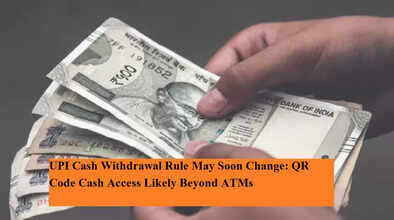UPI Cash Withdrawal Rule May Soon Change: QR Code Cash Access Likely Beyond ATMs

India’s digital payments landscape may soon see a major shift as the National Payments Corporation of India (NPCI) is working on a proposal to expand UPI-based cash withdrawals beyond ATMs. According to reports, NPCI has approached the Reserve Bank of India (RBI) for approval to allow customers to withdraw cash directly from over 20 lakh Business Correspondents (BCs) across the country by simply scanning a QR code.
Currently, UPI cash withdrawal is limited to a few UPI-enabled ATMs and select merchant outlets, with per-transaction limits of ₹1,000 in urban areas and ₹2,000 in rural areas. The new system aims to make cash withdrawals far more accessible, especially for people living in rural and remote locations where ATMs and bank branches are scarce.
How the New QR-Based Cash Withdrawal System Will Work
Under the proposed model, customers will be able to visit any BC outlet and withdraw cash by scanning a QR code using their UPI app. Once scanned, the specified withdrawal amount will be debited directly from the customer’s bank account and credited instantly to the BC’s account, allowing the customer to receive cash immediately.
This initiative is expected to particularly benefit people in semi-urban and rural areas, where access to physical banking infrastructure is often limited. By leveraging UPI’s widespread adoption, the system could serve as an alternative to micro-ATMs and Aadhaar-based biometric cash withdrawal systems.
Potential Benefits
-
Greater Accessibility: Expands cash access points to 20 lakh+ BC outlets across India.
-
Convenience: Eliminates the need to carry debit or credit cards.
-
Alternative Option: Provides a backup for cases where biometric systems fail due to poor fingerprint scans or technical issues.
-
Financial Inclusion: Encourages deeper digital adoption while supporting rural customers who still rely heavily on cash.
Concerns Around Cybersecurity and Fraud
While the move could significantly improve financial inclusion, experts have raised concerns over cybersecurity risks. Business Correspondents are sometimes unintentionally linked to fraudulent networks, making them vulnerable to exploitation. Unlike Aadhaar-based withdrawals, QR code–based withdrawals may make it easier for fraudsters to mask their identity.
Industry analysts suggest that strict safeguards, real-time monitoring, and customer awareness campaigns will be essential to ensure that the system remains secure and reliable.
Awaiting RBI Approval
At present, the proposal is in its early stages, and a final decision is yet to be made. If approved, the rollout could transform India’s cash withdrawal ecosystem by reducing dependency on ATMs and providing a more inclusive model.
Why It Matters
India has been steadily moving towards a cash-lite economy, but the demand for physical currency remains strong, especially in rural and semi-urban markets. By merging digital convenience with cash accessibility, the QR code withdrawal system could strike the right balance between innovation and practicality.
If RBI grants approval, the initiative could be a game-changer—expanding financial access, reducing the urban-rural divide, and furthering India’s journey toward a digitally empowered economy.

